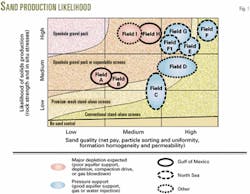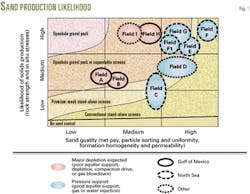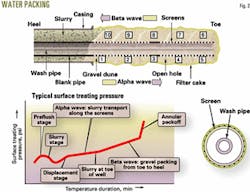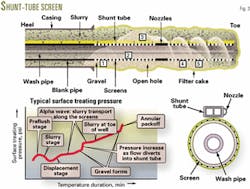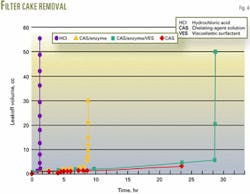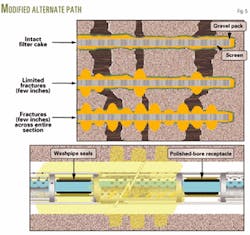Technology advances boost horizontal openhole gravel packing
Major advances in sand-control tools, gravel-packing methods, and drilling and completion fluid technology have made horizontal gravel-packed openhole completions, in some cases, economically more attractive than stand-alone screen completions.
But many challenges still remain to ensure the viability of such completions particularly in deep water and subsea wells where the cost of not getting it right the first time may prove the difference between economic success and failure.
Sand control
Because of productivity and economic reasons, most horizontal wells that require sand control are openhole completions.1 A large majority of these wells have stand-alone screens, although openhole gravel packing has gained wider acceptance in various parts of the world because of uncertainties in long-term sand-control integrity of stand-alone screens.2
Stand-alone screen completions have many different designs to improve their reliability. These designs range from simple wire wrapped to metal-mesh media and prepacked screens. The industry, however, has experienced numerous problems with stand-alone screen completions including plugging tendencies and formation-sand retention failure caused by localized high velocity hotspots that result in erosion. These failures may reduce ultimate reserves recovery from these fields.
During the last 2 decades, stand-alone screen failure rates have decreased from 50-65% to less than 20% as the industry improved drilling fluid design, drilling practices, mud displacement execution, completion installation, and cleanup techniques.3
Selecting completions
The industry has a large amount of data for developing much clearer guidelines for screen selection and gravel-pack sizing. The choice between a stand-alone screen or gravel pack has multiple dependencies that include rock permeability, concentration of clay and silt fines, formation sand uniformity and sorting, and the distribution and extent of exposed reactive shale sequences. 1 4
A cross plot (Fig. 1) of likely solids production with respect to formation sand quality helps operators develop guidelines for selecting completion methods. Wells in low to medium-quality reservoirs with a high propensity for sand production may need openhole gravel packs, but wells in high-quality sandstones with similar likelihood of sanding can be completed with stand-alone conventional wire wrap, prepacked, or premium-mesh screens.
Screen-only completions may be adequate in reservoirs with gas and water injection or strong aquifers for pressure support and medium to high-quality sands. Reservoirs of similar quality with depletion or compaction drive, however, may have to be gravel packed.
Most screen-only completions in the Gulf of Mexico and the North Sea wells fail during the first 3-4 years of production.5 6
Depending on rock properties, stand-alone screens may make more economic sense if flow rates are low and expected well life is short. This method also may be used in reservoirs having clean well-sorted sands and a high net-to-gross ratio.
Conversely, the completion engineer should consider gravel packing to mitigate screen plugging, screen erosion, and fines migration in poorly sorted sands with high fines content.
The main environments for which one should consider frac packing are low-permeability, dirty sands.
Downhole interventions are undesirable and affect overall project and asset economics of high cost, high-rate wells, including deepwater and subsea completions. These environments justify gravel packing because of the failure rates and uncertainty of other sand-control methods.
Some reasons not to gravel pack openhole horizontal wells include marginal economics, capital investment limitations, potential completion damage or productivity reduction, and loss of zonal isolation. Most operators, however, agree that gravel packing is preferred in horizontal openhole completions to reduce sand-related failures and minimize associated productivity decline.
High pressure, high-temperature (HPHT) wells may be exceptions because of fluid performance and compatibility limitations. HPHT sand-control presents challenges for completion engineers and these applications are under evaluation.
Gravel packing alternatives
Openhole gravel packing has evolved through experience and enhanced operator and service company understanding.
Two techniques currently available for gravel packing openhole horizontal wells are: water packing and viscous-fluid packing with alternate-path technology. These techniques have completely different packing mechanisms,7 8 and each method has its own advantages and limitations.
Gravel packing with low-viscosity fluids, usually brine, relies on deposition of gravel around screens on the low side of an annulus, while slurry with low gravel concentrations, 0.5-2 lb gravel added to 1 gal of fluid (ppa), moves in turbulent flow along the top. In this process, a reservoir drilling fluid (RDF) filter cake (formed during the drilling phase) must continue to seal off the borehole to minimize fluid leak-off.
Gravel moves toward the far end, or toe, of the horizontal section in an alpha wave (Points 1-5 in Fig. 2) if the job maintains fluid returns to surface.
If slurry dehydrates and forward packing ceases in intervals with high fluid losses, gravel fills the annulus and forms a bridge. This results in an incomplete pack beyond that point. After bridging occurs or gravel reaches the toe, packing proceeds back toward the beginning, or heel, of a horizontal section in a beta wave (Points 6-10 in Fig. 2).
Surface treating pressures provide an indication of how water-packing treatments are progressing. The placement of an RDF filter-cake cleanup solution must follow high-rate gravel packing because chemical treatment during placement greatly increases the risk of inducing high losses and a premature screen out or bridge.
In low net-to-gross dirty formations, gravel-pack impairment can occur through shale sloughing caused by the erosive action and high velocity of the slurry. Therefore, the process requires a more reliable method such as the alternate-path method.
The alternate-path method facilitates transport of 4-8 ppa gravel sand in a viscous carrier fluid and ensures a complete annular pack around screens across an entire horizontal section.
Shunt tubes attached on the outside of the screens provide pathways for slurry to bypass gravel bridges, exit specially designed nozzles, and fill annular voids (Fig. 3). Shunt packing does not rely on high velocity for transport or RDF filter cake integrity for preventing fluid loss.
If the annulus between screens and the openhole packs off prematurely (Point 3 in Fig. 3), slurry diverts into the shunts and gravel packing proceeds toward the toe even without fluid returns, or circulation to surface (Points 4-5 in Fig. 3). The procedure usually reduces pump rate after shunt flow begins and pressure increases because of small shunt-tube diameters.
Engineers have improved alternate-path screens for long horizontal openholes, greater than 2,000 ft, by:
- Designing components that reduce gravel buildup inside shunts.
- Using nondamaging fluids with good gravel-carrying capacity.
- Installing pipe shrouds with drilled holes around the entire assembly to help centralize screens and protect the shunt tubes while running in hole.
Another method for increasing the probability for obtaining a complete horizontal openhole gravel pack, where reactive shales are present, involves running a predrilled liner across the lateral prior to installing the screens. If the build section has not already been cased off, one can isolate it by placing a solid liner across the build section above the predrilled liner. If desired, one can also install external casing packers (ECPs) and a port collar to cement the build section.
Screens run inside of the predrilled liner are protected from any brine sensitive (reactive) shales that could collapse onto the screen and prevent a complete annular pack.
Gravel-placement simulation
Computer software allows one to design the critical steps in the gravel-pack process, which include:
- Gravel-placement for water and shunt packing.
- Pump schedules.
- Frac-pack treatments.
- Tubing movement.
- Packer hydraulics calculations.
- Torque and drag analysis.
Torque and drag simulations mitigate risk and help design screen assemblies to ensure running the hardware in hole to TD without getting it stuck or damaged.
Gravel-placement calculations are based on a pseudo-3D wellbore simulator1 capable of modeling horizontal or vertical, cased hole or openhole gravel packs. A model based on similar concepts also is available for simulating alternate-path gravel packing with shunt tubes.
Treatments can be designed with service tools in squeeze or circulating mode.
In a circulating position, the software also can model the surface valve or choke, pressure, and fluid-return rate.
The pump schedule module uses specific job requirements and input such as pump rate, gravel concentration, and fracture parameters to generate gravel-packing treatments. These inputs reduce the number of iterations needed to obtain satisfactory pump schedules.
Selecting a water or shunt-packing method requires the operators to assess logistics, risks, and costs for each application. Both techniques have been used successfully to gravel pack long, horizontal openhole wells.1 9 The success rate is about 70% for completely packing long openholes by high-rate water packing without an alternate path, while it is greater than 95% for alternate-path gravel packing.3
The risks and likelihood of success are related primarily to shale content and shale reactivity with drilling and completion fluids, the length of the reservoir section, and formation permeability.
When gravel packing with alternate-path screens, one can remove filter cake because a sealed wellbore is not required during gravel-packing operations.
New developments in this area over the last several years have mitigated risks associated with horizontal openhole gravel packs; uniform productivity, conformance, and completion longevity.
Filter-cake removal
The presence and nature of RDF filter cake can dominate gravel-pack plugging and may lead to significant production impairment. Simply flowing the well back and multiple-stage cleanup treatments with coiled tubing are two of the numerous methods employed to deal with this problem.
Various components of the filter cake (starch, biopolymer, CaCO3) are treated with different chemistries (enzymes, oxidizers, acids, and chelating agent solutions). Drilled solids often have the largest impact, and when these are absent, the overall filter-cake impact on productivity is often low or negligible.
High drawdowns often promote cake failure and facilitate production, but retained permeability can be as low as 1% or less as the cake becomes trapped between the gravel pack and the formation.
Neglecting the cake impact also can result in nonuniform production and premature water or gas breakthrough. To quantify this effect fully, one requires production logging.
Until recently after tubing was run, the chemical cleanup treatments after gravel packing with coiled tubing required a second round trip. A new service includes new fluid cleanup systems for filter-cake removal, one of which combines a chelating-agent solution (CAS) with an enzyme to attack starch and CaCO3 simultaneously. This treatment is placed slowly for more uniform wellbore cleanup during or after gravel packing.10
Test results indicate that filter-cake removal, the time at which a sharp increase in fluid leak-off occurs during an overbalanced soak, by a CAS is an order of magnitude slower than with hydrochloric acid (HCl). Also one can control removal times by adding more enzyme or viscoelastic surfactant (VES) to increase viscosity (Fig.4).
This low reaction rate allows a CAS and enzyme system to be placed in long horizontal wells without creating thief zones at initial contact points, a common occurrence with HCl.
In these cleanups, another significant concern is screen and well tubular corrosion. Laboratory tests on a 6-gauge wire-wrapped screen show that screen openings remain the same when exposed to CAS but increase from 150 to 250 æm with HCl treatments. This adversely affects sand control and completion integrity when soaking for extended time periods at high temperatures after gravel packing.
A new service tool is now available that reduces rig time and facilitates cleanup treatments by providing the following circulation path:
- First, down the work string and wash pipe.
- Then back across the annulus between wash pipe and screens.
- Finally, up to the surface via the annulus between work string and casing.
The tool uses the wash pipe inside screens to spot slow-reacting breaker solutions for filter-cake cleanup immediately after gravel packing.11 This process can eliminate the need for coiled-tubing cleanup treatments.
To further improve completions, operators have performed numerous simultaneous gravel packing and filter-cake removal well treatments with a polymer and solids-free cleanup-carrier fluid with VES gelling agent and alternate-path shunt screens.
Fig. 4 shows breakthrough times for RDF cake cleanup systems that can promote slower, more-uniform cake removal across a long horizontal openhole interval, thus avoiding thief zones that can occur with HCl.
This technique also reduces rig, coiled tubing, and fluid costs by eliminating post-pack cleanup treatments. Because alternate-path gravel packing ensures complete packs, it also may eliminate the need for premium-mesh screens as a backup sand-control measure.
Cleanup selection
Today, techniques for RDF filter-cake cleanup mainly rely on local knowledge or field specific historical treatments. Quite often the methods have not incorporated the industry's expertise in different geographic locations.
A query "help" system employing cased-based reasoning (CBR) software has been developed that includes numerous openhole completion criteria, including those pertinent to gravel packing, drilling, completion and cleanup fluid technology, and expertise.
The major impetus for creating this software was the extremely large number of filter-cake cleanup and placement solutions possible.
In the software, engineers answer yes or no to questions in a structured manner. The software eliminates solutions that do not fit the specific completion scenario.
The remaining steps in the selection process include field and laboratory database queries, lab tests if required, and nodal analysis or reservoir simulation to ascertain the cost benefit of the top three solutions developed from the CBR software.1
Emerging techniques
Expandable screen technology12 offers several major improvements for openhole completions, with one of the main ones being the elimination of gravel packs.
The current concerns for this immature technology are compliance (remaining annulus due to washouts) with the wellbore and ease of filter-cake removal.
Another novel technique that may significantly lower risks during gravel packing in openhole completions is oil-based, gravel-pack carrier fluids that facilitate several issues existing with current practices.13
To date, the industry has deemed only aqueous-based carrier fluids as suitable for the wide range of temperatures and pressures encountered in circulating openhole gravel packs.
This has also meant that water-based RDFs are preferred for openhole completions.
The main reason for this is that oil-based muds have the potential to form emulsion and sludges when displaced with aqueous-based carrier fluids. This results in a high risk of completion impairment. Another reason is that it is extremely difficult to remove oil-based RDF cake damage with conventional acid and mutual solvents.
New oil-based, gravel-pack fluids are oil external and brine-internal emulsions that have the following major benefits
- The openhole reservoir intervals may now be drilled with synthetic oil-based RDFs, with significant rig time savings and improved wellbore stability and quality.
- Displacement of the synthetic oil-based RDFs with an oil-based, gravel-pack carrier fluid involves much lower risk because the fluids are totally compatible and negate the risk of completion impairment through sludge formation.
- Because space is a premium on many offshore installations, a large challenge is to keep water and oil-based fluids separate to prevent cross contamination. An oil-based carrier fluid resolves this issue.
- The oil-based carrier fluids may include low corrosivity CAS in the brine internal phase. Synthetic oil-based RDFs are available that have all the properties of oil-based muds with the one exception that the fluid contains a unique surfactant package that enables the incorporated acid-soluble bridging agents to become water wet after exposure to low pH fluids.
The oil-based, carrier-fluid emulsion breaks down after the gravel pack has been placed. The chelant is then released from the internal phase which, by virtue of its pH (in the range of 2.5 to 4), attacks the emulsifier in the filter cake and reverses the strong solids oil-wet state to water wet, thus enabling facile dissolution by the CAS.
These new drilling and gravel-pack fluid combinations offer much greater efficiency and risk mitigation in openhole gravel packs. This is a major industry technical milestone that achieves high injectivity through openhole intervals drilled with synthetic oil-based RDF.
Fracturing pressure
Critical hardware elements that facilitate gravel placement above formation fracturing pressure include shunt screens with transport and packing tubes that ensure initiation of multiple fractures along long horizontal, openhole sections. To prevent fluid leak off into previously fractured sections and promote multiple fractures, seals placed on the internal wash pipe to match polished-bore receptacles in the screens isolate the annulus between wash pipe and screens over discrete intervals.
In addition to breaking through external and internal filter cake that is not removed by chemical treatments, potential benefits of gravel packing above formation fracturing pressure include additional stimulation to improve productivity or injectivity and reduce potential for plugging, especially for injection wells where increased flow area extends well life.
A similar process, reinjection of cuttings from drilling operations generates multiple fractures around injection points and demonstrates the feasibility of openhole gravel packing above fracturing pressure.
Operators in the Far East have successfully applied this technique to obtain well productivity that exceeded that in offset wells completed as openhole gravel-packed horizontals and cased-hole frac packs.14
Fig. 5 shows the configuration for openhole horizontal fracturing with modified alternate-path technology.
Acknowledgments
The authors thank the management of ChevronTexaco E&P Technology Co., Schlumberger Oilfield Services, and M-I LLC for permission to publish this article. F
References
- Ali, S., et al., "High-Productivity Horizontal Gravel Packs," Schlumberger Oilfield Review, Vol. 13, No. 2, Summer 2001.
- Jones, L.G., et al., "Alternate Path Gravel Packing," Paper No. SPE 22796, 66th SPE Annual Technical Conference and Exhibition, Dallas, Oct. 6-9, 1991.
- Bennett, C., et al., "Design Methodology for Selection of Horizontal Open-Hole Sand Control Completions Supported by Field Case Histories," Paper No. SPE 65140, SPE European Petroleum Conference, Paris, Oct. 24-25, 2000.
- Tiffin, D.L., King, G.E., Larese, R.E., and Britt, L.K., "New Criteria for Gravel and Screen Selection for Sand Control," Paper No. SPE 39437, SPE International Symposium on Formation Damage Control, Lafayette, La., Feb. 18-19, 1998.
- Perdue, J.M., "Completion Experts Study Gulf of Mexico Horizontal Screen Failures," Petroleum Engineer International, Vol. 69, No. 6, June 1996, pp. 31-32.
- McLarty, J., "How to Complete a Horizontal Well in the Gulf of Mexico, Operators Share Experiences," Petroleum Engineer International, Vol. 70, No. 11, November 1997, pp. 63-70.
- Parlar, M., et al., "Laboratory Development of a Novel, Simultaneous Cake-Cleanup and Gravel-Packing System for Long, Highly-Deviated or Horizontal Open-Hole Completions," Paper No. SPE 50651, SPE European Petroleum Conference, Hague, Netherlands, Oct. 20-22, 1998.
- Barrilleaux, M.F., Ratterman, E.E., and Penberthy, W.L. Jr., "Gravel Pack Procedures for Productivity and Longevity," Paper No. SPE 31089, SPE International Symposium on Formation Damage Control, Lafayette, La., Feb. 14-15, 1996.
- Tibbles, R., et al., "Design and Execution of a 3,000-ft Horizontal Gravel-Packed Completion (A Kazakhstan Case History)," Paper No. SPE 64410, SPE Asia Pacific Oil and Gas Conference and Exhibition, Brisbane, Australia, Oct. 16-18, 2000.
- Brady, M.E., et al., "Filtercake Cleanup in Open-Hole Gravel-Packed Completions, A Necessity or a Myth?" Paper No. SPE 63232, SPE Annual Technical Conference and Exhibition, Dallas, Oct. 1-4, 2000.
- Brady, M.E., et al., "Near Wellbore Cleanup in Openhole Horizontal Sand Control Completions, Laboratory Experiments," Paper No. SPE 58785, SPE International Symposium on Formation Damage, Lafayette, La, Feb. 23-24, 2000.
- Tiffin, D., et al., "Evaluation of Filter Cake Flowback in Sand Control Completions," Paper No. SPE 68933, SPE European Formation Damage Conference, Hague, Netherlands, May 21-22, 2001.
- Ladva, H.K.J., et al. "Use of Oil-Based Reservoir Drilling Fluids in Open-Hole Horizontal Gravel-Packed Completions, Damage Mechanisms and How to Avoid Them," Paper No. SPE 68959, SPE European Formation Damage Conference, Hague, Netherlands, May 21-22, 2001.
- Saldungaray, P.M., et al., "Frac-Packing Openhole Completions, An Industry Milestone," Paper No. SPE 73757, SPE International Symposium on Formation Damage, Lafayette, La., Feb. 20-21, 2002.
The authors
Syed A. Ali is a senior staff research scientist for ChevronTexaco E & P Technology Co., Houston. He specializes in sandstone acidizing, formation damage control, rock-fluid interaction, mineralogy, and oil field chemistry. Ali has an MS from Ohio State University and a PhD from Rensselaer Polytechnic Institute. He is a member of SPE.
Rick Dickerson is a completions engineer and senior advisor for ChevronTexaco Exploration and Production Co., Houston. He began his career with Gulf Oil Corp. and for the past 8 years, he has been responsible for sand control and horizontal well completion technology development and deployment worldwide. Dickerson has a BS in petroleum engineering from Louisiana Tech University. He is a member of SPE.
Mark E. Brady works for Schlumberger Oilfield Chemical Products R&D, Sugar Land, Tex. He develops new cleanup fluids and methodologies for openhole completions, particularly long horizontals requiring sand control. Brady has a BS in pure and applied chemistry and PhD in physical chemistry from the Queen's University of Belfast, Northern Ireland.
Mehmet Parlar is business development manager-fluid systems for Schlumberger's sandface completions business development team, Rosharon, Tex. He provides technical marketing and input to sand-control product development and worldwide field support on sand control and stimulation fluids. Parlar has a BS in petroleum engineering from Istanbul Technical University in Turkey, and an MS and a PhD in petroleum engineering from the University of Southern California at Los Angeles.
William E. Foxenberg is technical manager for M-I's completion fluids. He has worked in the oil and gas industry for the past 22 years, specializing in completion fluids for the past 15 years. His interests include formation damage, displacement technology, sand control and fluid-loss control. Foxenberg holds a BS in chemistry from the State University of New York College of Environmental Science & Forestry.
